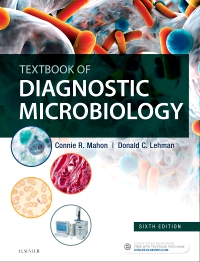
Textbook of Diagnostic Microbiology - Elsevier eBook on VitalSource, 6th Edition
Elsevier eBook on VitalSource

Now $109.79
Learn to develop the problem-solving skills necessary for success in the clinical setting! The Textbook of Diagnostic Microbiology, 6th Edition uses a reader-friendly "building-block" approach to the essentials of diagnostic microbiology. This updated edition has new content on viruses like Zika, an expanded molecular chapter, and the latest information on prevention, treatment modalities, and CDC guidelines. Updated photos offer clear examples of automated lab instruments, while case studies, review questions, and learning objectives present information in an easy-to-understand, accessible manner for students at every level.
Newer Edition Available
Textbook of Diagnostic Microbiology - Elsevier eBook on VitalSource
-
- A building-block approach encourages you to use previously learned information to sharpen critical-thinking and problem-solving skills
- Full-color design, with many full-color photomicrographs, prepares you for the reality of diagnostic microbiology
- A case study at the beginning of each chapter provides you with the opportunity to form your own questions and answers through discussion points
- Hands-on procedures describe exactly what takes place in the micro lab, making content more practical and relevant
- Agents of bioterrorism chapter furnishes you with the most current information about this hot topic
- Issues to Consider boxes encourages you to analyze important points
- Case Checks throughout each chapter tie content to case studies for improved understanding
- Bolded key terms at the beginning of each chapter equip you with a list of the most important and relevant terms in each chapter
- Learning objectives at the beginning of each chapter supply you with a measurable outcome to achieve by completing the material
- Review questions for each learning objective help you think critically about the information in each chapter, enhancing your comprehension and retention of material
- Learning assessment questions at the conclusion of each chapter allow you to evaluate how well you have mastered the material
- Points to Remember sections at the end of each chapter identify key concepts in a quick-reference, bulleted format
- An editable and printable lab manual provides you with additional opportunities to learn course content using real-life scenarios with questions to reinforce concepts
- Glossary of key terms at the end of the book supplies you with a quick reference for looking up definitions
-
- NEW! Content about Zika and other viruses supplies students with the latest information on prevention, treatment modalities, and CDC guidelines
- NEW! Expanded Molecular Diagnostics chapter analyzes and explains new and evolving techniques
- NEW! Updated photos helps familiarize you with the equipment you’ll use in the lab
- NEW! Reorganized and refocused Mycology chapter helps you better understand the toxicity of fungi
- NEW! Updated content throughout addresses the latest information in diagnostic microbiology
-
Part 1: Introduction to Clinical Microbiology
1. Bacterial Cell Structure, Physiology, Metabolism, and Genetics
2. Host-Parasite Interaction
3. The Laboratory Role in Infection Control
4. Control of Microorganisms: Disinfection, Sterilization, and Microbiology Safety
5. Performance Improvement in the Microbiology Laboratory
6. Specimen Collection and Processing
7. Microscopic Examination of Materials from Infected Sites
8. Use of Colony Morphology for the Presumptive Identification of Microorganisms
9. Biochemical Identification of Gram-Negative Bacteria
10. Immunodiagnosis of Infectious Diseases
11. Applications of Molecular Diagnostics
12. Antibacterial Mechanisms of Action and Bacterial Resistance Mechanisms
13. Antimicrobial Susceptibility Testing
Part 2: Laboratory Identification of Significant Isolates
14. Staphylococci
15. Streptococcus, Enterococcus, and Other Catalase-Negative, Gram-Positive Cocci
16. Aerobic Gram-Positive Bacilli
17. Neisseria Species and Moraxella catarrhalis
18. Haemophilus, HACEK, Legionella and Other Fastidious Gram-Negative Bacilli
19. Enterobacteriaceae
20. Vibrio, Aeromonas, and Campylobacter Species
21. Nonfermenting and Miscellaneous Gram-Negative Bacilli
22. Anaerobes of Clinical Importance
23. The Spirochetes
24. Chlamydia, Rickettsia, and Similar Organisms
25. Mycoplasma and Ureaplasma
26. Mycobacterium tuberculosis and Nontuberculous Mycobacteria
27. Medically Significant Fungi
28. Diagnostic Parasitology
29. Clinical Virology
30. Agents of Bioterror and Forensic Microbiology
31. Biofilms: Architects of Disease
Part 3: Laboratory Diagnosis of Infectious Diseases: and Organ System Approach to Diagnostic Microbiology
32. Upper and Lower Respiratory Tract Infections
33. Skin and Soft Tissue Infections
34. Gastrointestinal Infections and Food Poisoning
35. Infections of the Central Nervous System
36. Bacteremia and Sepsis
37. Urinary Tract Infections
38. Genital Infections and Sexually Transmitted Infections
39. Infections in Special Populations
40. Zoonotic Diseases
41. Ocular Infections
Appendix A: Selected Bacteriologic Culture Media
Appendix B: Selected Mycology Media, Fluids, and Stains
Appendix C: Selected Procedures
Appendix D: Answers to Learning Assessment Questions


 as described in our
as described in our 